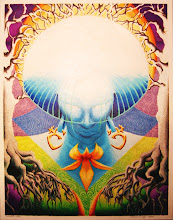
Tikal Temple 1: " The Maya of Tikal considered Temple I the portal to the Underworld. Ha Sawa Chaan K’awil’s rich tomb was discovered in the interior of the building (Burial 116). Yikin, his son, sealed the tomb after his father's death, before construction began on the temple. Being buried in this spot was a huge break with tradition. Before this time, for more than 500 years, all the rulers of Tikal were buried in the North Acropolis. His royal tomb included several kilos of jade, shells and pottery. Ha Sawa Chaan K'awil was almost 6 ft. tall and his body was left under Temple I after his death with a richly adorned burial, which was excavated by archaeologist Aubrey Trik in 1962. The temple complex may represent the Full Cycle of Life itself."

Pillar from a Jain Kama Sutra Temple.

Unknown Buddhist temple.

The famous St. Basil's Cathedral was commissioned by Ivan the Terrible and built on the edge of Red Square between 1555 and 1561. Legend has it that on completion of the church the Tsar ordered the architect, Postnik Yakovlev, to be blinded to prevent him from ever creating anything to rival its beauty again. (He did in fact go on to build another cathedral in Vladimir despite his ocular impediment!) The cathedral was built to commemorate Ivan the Terrible's successful military campaign against the Tartar Mongols in 1552 in the besieged city of Kazan. Victory came on the feast day of the Intercession of the Virgin, so the Tsar chose to name his new church the Cathedral of the Intercession of the Virgin on the Moat, after the moat that ran beside the Kremlin. The church was given the nickname "St. Basil's" after the "holy fool" Basil the Blessed (1468-1552), who was hugely popular at that time with the Muscovites masses and even with Ivan the Terrible himself. St. Basil's was built on the site of the earlier Trinity Cathedral, which at one point gave its name to the neighboring square.

The Temple of Edfu is an ancient Egyptian temple located on the west bank of the Nile in the city of Edfu. It is the second largest temple in Egypt after Karnak and one of the best preserved. The temple, dedicated to the falcon god Horus, was built in the Ptolemaic period between 237 and 57 BCE. The inscriptions on its walls provide important information on language, myth and religion during the Greco-Roman period in ancient Egypt. They are translated by the german Edfu-Project.

unknown.

Wat Chai Wattanaram: Standing right on the river, Wat Chai Wattanaram is, in our view, one of the most impressive of the remaining monuments of old Ayutthaya. It was built in 1629 by King Prasat Tong, probably on the site of his mother's cremation. King Prasat Tong was actually a commoner who overthrew the previous king and took the throne. The monastary may well have been established to assert his legitimacy to the throne.

Angkor Wat:
Angkor Wat (or Angkor Vat) (Khmer: អង្គរវត្ត), is a temple at Angkor, Cambodia, built for King Suryavarman II in the early 12th century as his state temple and capital city. As the best-preserved temple at the site, it is the only one to have remained a significant religious centre since its foundation—first Hindu, dedicated to Vishnu, then Buddhist. The temple is the epitome of the high classical style of Khmer architecture. It has become a symbol of Cambodia, appearing on its national flag, and it is the country's prime attraction for visitors.
Angkor Wat combines two basic plans of Khmer temple architecture: the temple mountain and the later galleried temple. It is designed to represent Mount Meru, home of the gods in Hindu mythology: within a moat and an outer wall 3.6 km (2.2 miles) long are three rectangular galleries, each raised above the next. At the centre of the temple stands a quincunx of towers. Unlike most Angkorian temples, Angkor Wat is oriented to the west; scholars are divided as to the significance of this. The temple is admired for the grandeur and harmony of the architecture, its extensive bas-reliefs and for the numerous devatas (guardian spirits) adorning its walls.
The modern name, Angkor Wat, in use by the 16th century,[1] means "City Temple": Angkor is a vernacular form of the word nokor which comes from the Sanskrit word nagara (capital), while wat is the Khmer word for temple. Prior to this time the temple was known as Preah Pisnulok, after the posthumous title of its founder, Suryavarman II.[2]

Temple of Manu Rishi:
This is the only temple of Manu in India. Manu was believed to be the creator of the human race.


No comments:
Post a Comment